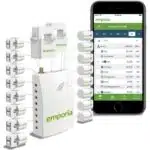The Best Home Energy Monitors
Home energy monitors are compact devices (the size of a mobile phone) that show how much energy your household is using. Besides energy usage, home monitors provide detailed data about which appliances take the most energy and need an upgrade. If provided with enough information, you can decide which devices could be turned off, for you to save money when paying utility bills.
Tucked inside an electrical panel, a home energy monitor communicates data via Wi-Fi and current transformers. The monitor connects to your mobile phone allowing you to track energy usage in real-time, and check whether you turned off appliances before leaving your home. For those who already installed solar panels in their homes, the home energy monitor can show how much energy the panels are generating and saving in total.
It is no wonder that home energy monitors are now more popular than ever: utility prices are rising, the climate is changing, and people are becoming more conscious about their energy consumption. “Households save an average of nearly 10% on their power bills in the year after installing a monitor, with more engaged people saving up to twice that,” as per Wirecutter.
Overall home energy monitors are designed to optimize the performance of each appliance (or locate forgotten ones) and reduce electricity consumption. However, while home energy monitors sound like a practical tool to save you money, in reality, they cannot reduce your energy bill. The device is simply providing you with information. (Some of the other smart devices you can purchase for your home to reduce energy usage are smart thermostats, and smart light switches (together with LED light bulbs and smart outlets.)
At the same time, even if home energy monitors do not directly participate in lowering your utility bills, they have one main advantage—catching up on so-called vampire loads. Vampire loads are appliances that draw out power even when not in use. As soon as one of those vampire appliances is located you would have to unplug it and shut off the power strip the device is connected to.
WARNING: Home energy monitors might seem easy to install. Still, as per manufacturers’ suggestions, installation must be trusted to professional electrics. Simply because a monitor will have to be attached to your house’s electrical panel with hazardous wires, your life might be in danger.
What To Look For in an Energy Monitor
Type:
Besides household electricity monitors, there are also individual appliance monitors. The latter one focuses on a single appliance to give you more detailed data whether it is a washing machine or water heater that drains out energy. Household energy monitors, on the contrary, provide you with a house-wide picture of energy usage.
Cost tracking:
That is not the feature of every home energy monitor. However, if real-life cost tracking is important for you to have, look out for devices that offer it. Monitors that come with a cost tracking function provide you with precise figures for electricity consumption and its cost decrease or increase.
Appliance compatibility:
Just like with cost tracking, not every energy monitor offers appliance recognition. The feature means you will plug it into your circuit breakers to detect how every appliance in your house uses electricity.
It is also worth mentioning that monitors with appliance recognition work flawlessly only when it comes to detecting the difference between devices that use a different amount of electricity (think refrigerator and TV or a microwave). Smaller appliances such as toasters, hair curlers, electric teapots and others are more challenging to differentiate.
Apps compatibility:
One of the main advantages of installing a home energy monitor is to receive notifications on your phone about energy consumption, appliance activity, cost tracking and warnings about increased usage. For peace of mind, use compatible apps to check whether you turned off appliances when leaving your home.
Emporia Energy Gen 2 Vue Smart Home Energy Monitor
Features
The smart home energy monitor by Emporia Energy provides the most recent data about energy cost and usage. The Gen 2 Vue monitor features sixteen sensors that are fastened to individual circuits (to monitor large appliances), and small plugs (for smaller appliances).
Anyone with a solar home can also use Emporia Energy Gen 2 Vue monitor to track the difference between any excess energy going back to the grid and overall household energy consumption.
The Emporia Energy Gen 2 monitor functions by relying on the actions of the owner which helps to identify potential ways to save on utility. It also allows you to use the Vue app for smart plugs, thermostat control and watch over real-life energy measurements. Moreover, the compatible app allows you to set the timer and use the Emporia Energy app to control the energy monitor.
Keep in mind that while this monitor has sixteen sensors only eight are included. (You can purchase eight more to use the monitor for individual circuits that power the laundry room, HVAC and other appliances.) While it is suggested to call a professional to install an energy monitor, the individual circuit transformers can be just clipped onto circuits. Do not forget to shut off the breaker box.
Whoever is looking to locate vampire load and wants to know how much energy one specific appliance is consuming, the Emporia Energy Gen 2 is an ideal monitor for those purposes.
Pros
- Sixteen sensors.
- Notifications can be customized.
- Compatible with solar homes.
Cons
- Data does not get stored on your device which makes it difficult to retrieve from the cloud.
- No Bluetooth support.
Sense Energy Monitor
Features
Sense Energy monitors were some of the earliest on the market. The device is capable of capturing your home power usage in million measurements per second and shows you how much energy each appliance is drawing out.
What the Sense Energy monitor relies on to recognize individual devices is machine learning. Further, you get information about potential waste, usage of power, and appliance activity even when you are away from home.
You can also connect the Sense monitor to your home smart assistant (Alexa, Google Assistant) and use voice commands for any energy adjustments. The compatible app allows you to set customized notifications to know whether a device has been running for too long, or if you turned off an appliance.
The base model of this monitor offers ease of use, and that is why many reviewers prefer this full-featured device. Sense Energy monitor learns your appliances’ cycles. For more efficient results you could also add individual sensors to the HVAC system. Keep in mind that the standard Sense Energy monitor is designed for homes without solar. If you have solar panels installed take a look at the Sense Solar monitor.
Pros
- Customizable notifications.
- Comes with a compatible app.
- Connects with smart home assistants.
Cons
- Might take some time to detect all appliances at the beginning.
Topgreener Smart Outlet with Energy Monitoring
Features
If you do not wish to install a whole-home energy tracking system, Topgreener Smart Outlet is the solution. The smart Wi-Fi outlet can monitor the energy of individual outlets and is compatible with multiple appliances.
Topgreener is compatible with a phone app which allows you to turn appliances on and off, set schedules, and integrate it with virtual assistants (Google Assistant, Alexa). Moreover, you could customize and run timers, and create an “Away” mode to track appliance activity when you are not home.
Another feature why many users chose Topgreener is the ability to turn on a heater when the weather cools off or turn on the fan during hot summer days.
Unlike the whole-house system, the Top Greener Smert outlet does not need a professional electrician’s assistance to be installed. Simply plug it into the wall and then plug any appliance into the smart outlet.
Pros
- Wi-Fi monitored outlet.
- Compatible with a phone app.
- Compatible with a smart home assistant.
Cons
- Needs manual reset every time when power goes out.
Topgreener Smart Outlet with Energy Monitoring
Generac PWRview W2
Features
Generac PWRview W2 is similar to the Sense monitor in using machine learning to identify how much energy every appliance is using. The monitor uses 2.4 GHz Wi-Fi and Bluetooth to connect to your phone and offers you flawless integration with smart home assistants such as Alexa, Google Home, and Apple HomeKit for easy voice control.
More affordable than the Sense monitor, Generac PWRview works with houses that have solar panels installed. If your home already has a Generac system, the PWRview W2 monitor will provide an even smoother connection.
Considering that this is a relatively new model, there are limited reviews on PWRview. However, it received overall high marks for customer service responsiveness and helpfulness. (In comparison, reviewers were not happy with Sense’s customer service.)
Pros
- Responsive customer service.
- Compatible with a smart home assistant.
Cons
- The connection is not as flawless as with other monitors.
Frequently Asked Questions
What is an energy monitor?
An energy monitor is a device that connects to your household electricity meter. After connecting, the monitor will show how much power appliances are using. With that data, you can figure out ways to make your home more energy-efficient and save on your utility bills.
What are the benefits of an energy monitor?
Besides being able to tell you the overall power usage of your household, an energy monitor also allows a closer look at your electricity bill. You can not only see how much electricity you have used over a month but also the applicable charges.
That is as much as an energy monitor can tell you. Further, you would have to take steps and make decisions on how to save money and reduce your carbon footprint. Yet, instead of guessing which appliances have to be turned off, you can simply collect data from the energy monitor.
How to monitor a house’s electricity usage?
An energy monitor is an efficient and easy way to measure the overall power usage of a household. However, an energy monitor as a device is not going to change your habits. Before installing an energy monitor make sure your home is already energy efficient.
What consumes the most electricity in a home?
Among the top five most energy-consuming home appliances are washing appliances (machines, dishwashers), cold appliances, cooking appliances, electronics and lighting. However, around 50-70% of energy costs are related to heating and/or cooling.
What are the disadvantages of an energy meter?
An energy meter has certain flaws, such as erroneous results in case of power fluctuations, and a pause in electricity readings in cases when the meter stops working.















